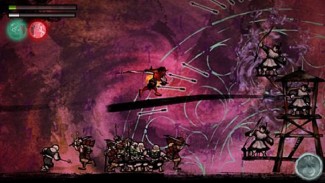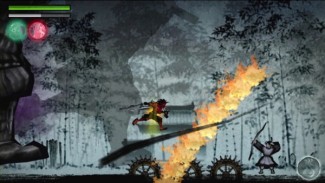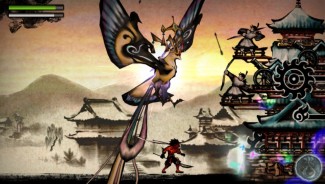Bastion
LQ: 9.15
Recommended Age: 10+
Skills Used: Planning, Working Memory, Mathematics, Reading

In Sumioni: Demon Arts, players take on the role of the lethargic demon Agura, who must save Japan from the evil forces striving to rule the country. Agura is an “ink demon,” and has the ability to brush ink strokes into the world to cut down enemies and save the day — if he can stop himself from taking a nap first. The game takes advantage of the PS Vita’s touch screen to let players draw visual brushstrokes that can create platforms, slice enemies, cast fire, call upon lighting, and even summon “inkgods” who aid Agura on his journey. Players must learn how to use their new brush-wielding abilities to navigate through levels filled with obstacles, enemies, and boss battles. To get the best scores possible, they will need to learn how to beat each stage quickly while taking as little damage as possible. The better a player scores, the more likely their chances of achieving a better ending and saving Japan. Sumioni: Demon Arts features mild cartoon violence, but no blood, and offers a moderately high level of difficulty, so it is only recommended to players ages 10 and up.
Recalling and retaining information in our minds while working.
 Sumioni: Demon Arts presents extensive information for players to recall during gameplay, flexing their Working Memory skills in a variety of ways. The game’s touch-based commands require players to recall specific brushstrokes and patterns to issue attacks and summon allies, while the varying enemy types each demand different strategies to overcome. Levels can be replayed multiple times to achieve higher scores, too, allowing players to memorize the layout of each level to better anticipate enemies and obstacles.
Sumioni: Demon Arts presents extensive information for players to recall during gameplay, flexing their Working Memory skills in a variety of ways. The game’s touch-based commands require players to recall specific brushstrokes and patterns to issue attacks and summon allies, while the varying enemy types each demand different strategies to overcome. Levels can be replayed multiple times to achieve higher scores, too, allowing players to memorize the layout of each level to better anticipate enemies and obstacles.
Developing a systematic approach for setting and achieving goals.
Players must plan out their strategy in Sumioni to achieve the highest score possible. This includes simple actions, such as the best area to place a brushstroke, to more complex concepts, like what type of attack to use on what enemy. Since the ink used to create brushstrokes is a finite resource, players must carefully strategize their actions and anticipate how much ink they will need for a particular fight or move. If players fail to wisely budget their use of ink, they may be unable to call their powers into action during the most crucial parts of the game.
Understanding our own actions, thoughts and feelings.
 The ability to learn from mistakes and improve upon performance is an important aspect of progressing successfully through Sumioni. Players must be able to analyze what works well in a level and think of new ways to use their powers when they reach difficult obstacles or bosses in gameplay. Through the three-star scoring system, Sumioni allows players to reach different endings based on how well they can learn from their mistakes and increase their score.
The ability to learn from mistakes and improve upon performance is an important aspect of progressing successfully through Sumioni. Players must be able to analyze what works well in a level and think of new ways to use their powers when they reach difficult obstacles or bosses in gameplay. Through the three-star scoring system, Sumioni allows players to reach different endings based on how well they can learn from their mistakes and increase their score.
Use this PlayTogether guide to learn how you can help your child turn Sumioni: Demon Arts play time into a positive learning and relationship-building experience. To learn more about why playing games with your children is so important, check out our Science of Play page.
Take a minute to talk with your child about how the Working Memory, Planning, and Self-Awareness thinking skills work, and why they are important for success in school and at home.
 Sumioni: Demon Arts is a single-player game, but still can easily be enjoyed by you and your child. Seeing as the best way to bolster your score is to replay levels until you perfect them, the game is best enjoyed by passing the device back and forth between attempts, seeing who can earn three stars in a level first or attempting to achieve the gameplay goals listed below.
Sumioni: Demon Arts is a single-player game, but still can easily be enjoyed by you and your child. Seeing as the best way to bolster your score is to replay levels until you perfect them, the game is best enjoyed by passing the device back and forth between attempts, seeing who can earn three stars in a level first or attempting to achieve the gameplay goals listed below.
Gameplay Goals:
After you and your child have completed the gameplay goals above, take a moment to pause the game and discuss the importance of the thinking skills at play.
Our Make it Work activities are designed to transform your child’s gameplay into real-world improvements in thinking and academic skills. If you’re just getting started with LearningWorks for Kids, we suggest you try them all to find which are the best for you and your child.
Read over the pages for Working Memory, Planning, and Flexibility. Then take some time to introduce these Thinking Skills to your child.
Explain That:
 Use visual reminders for regularly practiced tasks. For example, a series of leaving for school pictures might be posted near the door. These might include pictures of someone brushing his teeth, putting lunch in a book bag and kissing mom or dad goodbye. Encourage your child to develop his own set of visual aids for memory. Practicing visualization skills, such as keeping an image in mind of what he wants to remember, would also help.
Use visual reminders for regularly practiced tasks. For example, a series of leaving for school pictures might be posted near the door. These might include pictures of someone brushing his teeth, putting lunch in a book bag and kissing mom or dad goodbye. Encourage your child to develop his own set of visual aids for memory. Practicing visualization skills, such as keeping an image in mind of what he wants to remember, would also help.
Anticipate the future. Demonstrate the need to plan ahead based upon schedules or upcoming events. If the lawn needs to be cut, discuss how your child needs to start the job in time so she can finish before dark or before it rains. Help your child to see parallel situations such as getting homework done before cousins visit or planning to shop for supplies to complete a project before the store closes. Use large, visual calendars for planning. This is particularly helpful for younger children when they can place the calendars in their rooms and decorate them on their own. Use visual cutouts to represent activities. Children may wish to use a digital photo of a baseball to remind them of baseball practice or a violin or another instrument to remind them of music lessons.
 Make a game out of you and your child checking each other’s work for mistakes. For example, divide a math assignment and each do half. Make sure that you make mistakes on your half so that your child will have to correct them. Similar strategies can be used with word searches, crossword puzzles, and Sudoku. Discuss methods such as being aware of mathematical signs (+/-) and “lining up” columns for addition and subtraction.
Make a game out of you and your child checking each other’s work for mistakes. For example, divide a math assignment and each do half. Make sure that you make mistakes on your half so that your child will have to correct them. Similar strategies can be used with word searches, crossword puzzles, and Sudoku. Discuss methods such as being aware of mathematical signs (+/-) and “lining up” columns for addition and subtraction.
All membership plans come with full access to our entire suite of tools learning guides, and resources. Here are a few of the ones we think you’ll like the most: